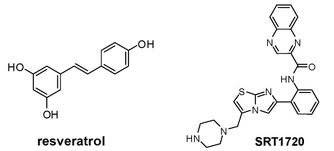ResveratrolConsumer
avert online
consumer fraud
ResveratrolQuiz
test your knowledge
New E-Book
How the world got lost on
the road to an anti-aging pill
Subscribe to our newsletter to receive email notifications when new articles are posted.
August 18, 2011: by Bill Sardi
The announcement today, published in The New York Times, that a synthetic drug, SRT1720, produced by Sirtris Pharmaceuticals, mimics resveratrol and overcomes fatty liver which results in a 44% increase in the life span of laboratory animals, is the re-emergence of this company’s visibility since its failed (but half-hearted) venture to market a resveratrol pill. GlaxoSmithKline, the parent to Sirtris, abandoned further research and development for its SRT501 resveratrol (rez-vair-ah-trol) drug when mega-doses induced kidney failure in a human trial among bone marrow cancer patients.
The quest to develop these small-molecule drugs began in 2003 when Harvard researchers linked a resveratrol, a red wine molecule, with a key gene — Sirtuin1 – thought to be activated in calorie restricted animals that results in prolongation of life span.
A similar study was conducted and reported in 2006 showing the life span of rodents is extended in mice fed a high-fat calorie diet. But a subsequent study conducted among mice given a normal calorie diet did not extend life span.
While SRT1720 may be a remedy for fatty liver, a problem that occurs in roughly 35% of American adults, whether it lives up to its calling as an anti-aging pill remains to be demonstrated.
SRT1720 is not a resveratrol-like molecule in structure. It may be similar in activity, but probably narrower in its ability to target genes. You can read our report about it here:

Working on a theory that SIRTUIN1 is the primary target gene, SIRTRIS Pharmaceuticals has been attempting to develop synthetic Sirtuin1-activating drugs. However, the primacy of Sirtuin1 in aging has been brought into question if for no other reason than Sirtuin1 is not consistently activated in all tissues and organs of calorie restricted mice that exhibit a 50% increase in life span. Over-activation of Sirtuin1 has also been shown to be problematic.
At least in the mitochondria, the power plants inside living cells, and where 90% of the oxidation occurs in the human body, Sirtuin3 appears to be the key gene. Resveratrol activates Sirtuin3, Longevinex even more so. You can read the report here.
Cayman Chemical lists SRT1720 has having a molecular weight of 469.60 compared to 228.0 for resveratrol. Smaller molecules do a better job of penetrating cells walls and navigating into the genetic machinery in the nucleus of the cell. So these molecules cannot be considered equivalent. Fisetin, mirecetin, quercetin, ferulic acid are natural molecules found in red wine that more closely mimic resveratrol.
Modern drugs can be generally described as synthetic molecules designed to target single cell-receptor sites or single gene targets to quell a single disease. Nutriceuticals like resveratrol are natural small molecules that exert broad action over the many genes and address many diseases in one pill. – Copyright 2011 Bill Sardi, ResveratrolNews.com August 18, 2011
Posted in Resveratrol
Add comments »